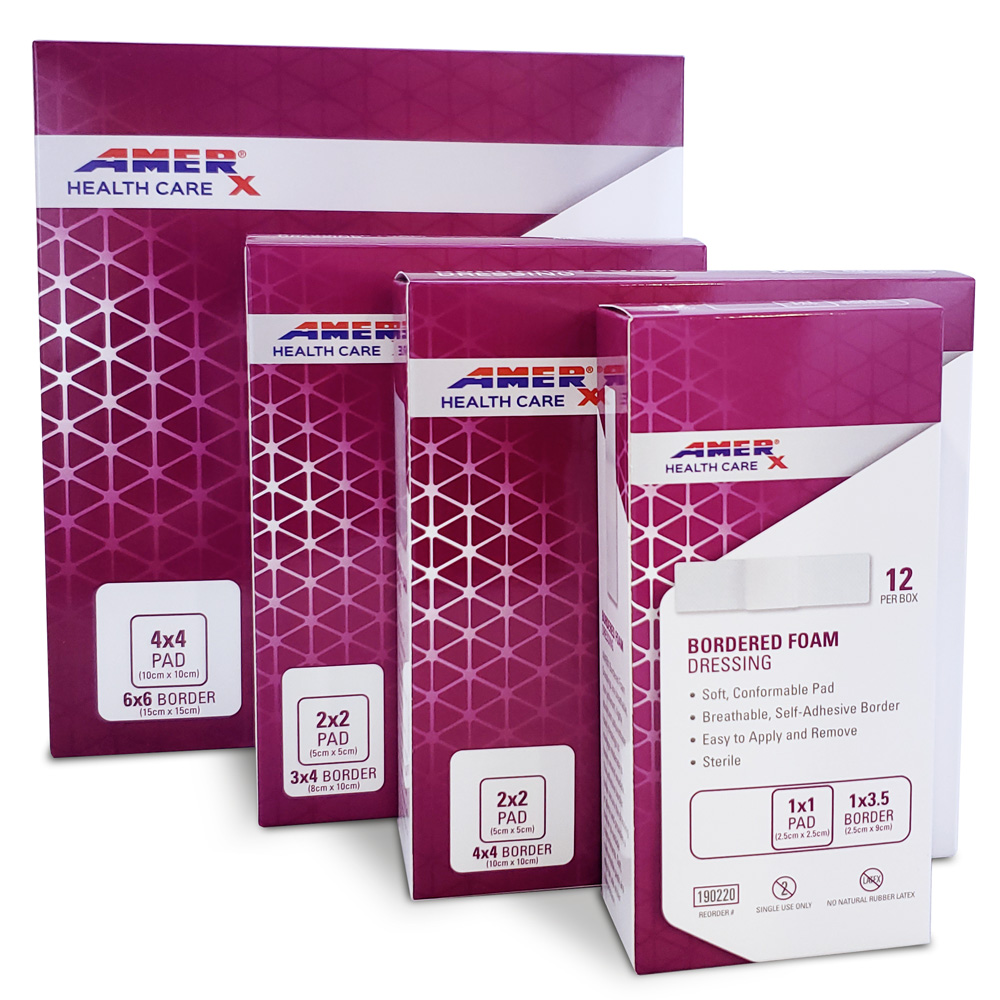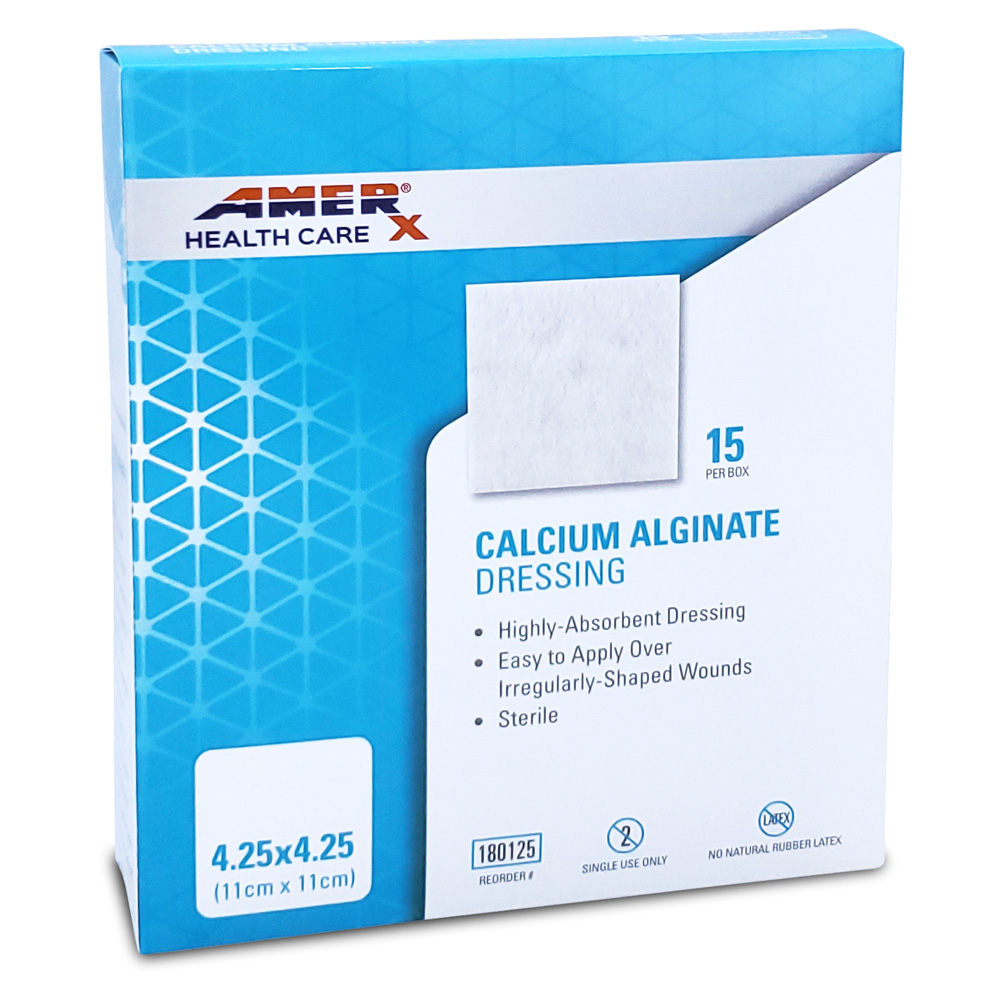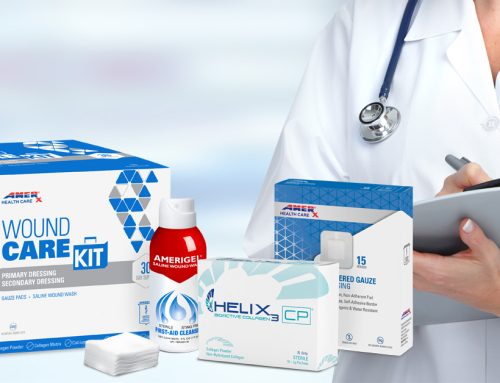Introduction
Participation in the surgical dressing program with AmerX products offers tremendous advantages to both patients and providers. Patients receive high quality, efficacious products that help in the care of their wounds. Providers enjoy supplying their patients with high quality wound care products that improve outcomes without the need to deal with a third party pharmacy. Examples of surgical dressings from AmerX include collagen, calcium alginate, foam, gauze, hydrocolloids, hydrogel, and compression garments.
The Program
Practitioners who dispense surgical dressings typically purchase the surgical dressings and stock them in their office. Practitioners can then dispense the dressings to patients for whom the dressings are medically necessary. By this method, practitioners know their patients are receiving the high quality products the patients need, and patients gets what they need without having to travel anywhere other than the practitioner’s office.
Practitioners can also participate in the AmerX Patient Direct program whereby surgical dressings are ordered by the practitioner and delivered directly to the patient’s home. By either method, practitioners may enjoy profits for their businesses because the third party payer reimbursement associated with the surgical dressings is often significantly higher than the costs.
Third-Party Payers

Non-Medicare third party payers may have their own coverage policies, but most non-Medicare third party payers that provide this benefit use the same guidelines that are provided by the DME MACs.
Just like every other service practitioners provide for beneficiaries of third party payers, there are compliance guidelines to consider when participating in the surgical dressing program. Fortunately, the guidelines for dispensing surgical dressings to Medicare beneficiaries are very clearly outlined. Both DME MACs list the same guidelines governing coverage of surgical dressings for Medicare beneficiaries in their “Surgical Dressings” Local Coverage Determination (L33831) and “Surgical Dressings” Policy Article (A54563). Because there are only two DME MACs in the US and their surgical dressing policies are identical, the compliance guidelines are the same for all Medicare providers in the country.
Reasons for Denial
Reason #1
“The Medical Records Received Lack Sufficient Information Concerning the Beneficiary’s Condition to Determine If Medical Necessity Coverage Criteria Were Met.”

There are many others. When dispensing surgical dressings, it is suggested that providers make the medical necessity of the surgical dressings very clear and not rely on an auditor’s ability to determine medical necessity based on their reading of the past medical history and the history of present illness alone. Providers may even consider documenting a sentence that starts with, “This surgical dressing is medically necessary because………” Including a sentence like this removes the risk associated with an auditor or other third party payer representative attempting to find or interpret medical necessity based on other contents of the documentation.
An example of a portion of a progress note that clearly demonstrates the medical necessity of collagen powder is:
This is a chronic ulcer. This ulcer is not demonstrating signs that lead me to believe it will heal if current treatment continues and advanced healing options are not instituted. Ulcers of this nature have a high rate of failure to heal, and high rates of infection, amputation, other morbidity, and even mortality associated with them. Therefore, advanced treatment in the form of collagen powder is medically necessary and indicated in an effort to heal this chronic ulcer and prevent amputation. Collagen was selected as this wound is stalled and not progressing toward the goal of healing the way it should be. I expect the collagen to attract monocytes and fibroblasts, act as a sacrificial substrate for MMPs, and ultimately provide a matrix for tissue and vessel growth.
The information in the rest of the note should support this statement of medical necessity. The DME MAC policies do not list any requirements regarding the number of weeks a wound must be present for coverage of surgical dressings. They also do not list a certain number of weeks that must have passed during which a wound failed to respond to other treatment options.
AmerX offers an entire webinar devoted to this topic of medical necessity.
Reason #2
“The Monthly Evaluation of The Wound by The Healthcare Professional Did Not Include the Type of Each Wound, Its Location, Its Size and Depth, The Amount of Drainage and Any Other Relevant Information.”
The DME MAC Surgical Dressings policies require that the clinical information demonstrating the medical necessity of dispensed surgical dressings be updated monthly if the patient is using the product(s) for more than one month. If the patient who has received surgical dressings is in a nursing facility or if the patient has a heavily draining or infected wound, this update must be performed weekly. In this situation, the update may be performed by the prescribing / dispensing physician, a nurse, or any health care professional that is involved in the regular care of the patient.
The monthly (or weekly) required evaluation should include:
- Wound type(s)
- Wound(s) location
- Wound(s) size
- Wound(s) drainage quantity
- Any other relevant wound status information
The supplier does not necessarily have to be the one to perform this update. Compliance can be met if someone other than the supplier performs the evaluation and the supplier obtains the information, retains that information in the patient’s record, and documents the source of the information and the date obtained. This AmerX webinar details the requirements of this monthly evaluation.
Reason #3
“The Medical Records Do Not Show That the Foam Dressing Is Being Used on A Full Thickness Wound with Moderate to Heavy Exudate (Stage III or Stage IV Ulcer).”

Requirements for coverage of surgical dressings for Medicare beneficiaries include:
-
- The dressing(s) are medically necessary
- The exudate quantity of the wound(s) to be treated is documented
- Debridement of the wound to be treated was medically necessary and it was debrided, or the surgical dressings are to be used in the treatment of an ulcer caused by or treated by a surgical procedure
In addition to these general requirements for coverage of all surgical dressings, each surgical dressing type has its own individual coverage requirements. These additional requirements for foam include the wound having moderate to heavy exudate and being full thickness. This AmerX blog discusses use of foam in treating wounds.
Reason #4
“Frequency of Use or Frequency of Change Is Not Supported by The Medical Records.”
In addition to other requirements, documentation created when surgical dressings are dispensed should include:
-
- Ulcer type
- Ulcer type
- Ulcer Stage
- Ulcer length, width, and depth
- Number of dressings dispensed
- Number of wounds being treated
- Frequency of surgical dressing changes
- Anticipated duration of surgical dressing requirement

If a kit is dispensed with multiple surgical dressing types, then these documentation requirements must be met for each dressing included in the kit. Documenting the frequency of dressing changes can help avoid this fourth most common reason for surgical dressing claim denial. An example of satisfying this requirement may be:
“The patient was instructed to apply this collagen in the same manner that was demonstrated today once a day every day and then cover it with secondary dressings dispensed at least until I see them again next week.”
Reason #5
“The Medical Records Do Not Establish That the Dressing Is Being Used as A Primary or Secondary Dressing or For Some Non-Covered Use (For Example, Wound Cleansing).”
The DME MACs state that surgical dressings may serve as either a primary dressing or a secondary dressing.
The DME MACs provide these definitions::
Primary Dressing – Therapeutic or protective covering applied directly to wounds or lesions either on the skin or caused by an opening to the skin.
Secondary Dressing – Materials that serve a therapeutic or protective function and that are needed to secure a primary dressing.
Some surgical dressings can only serve as a primary dressing, some can only serve as a secondary dressing, and some can serve as either a primary or secondary dressing, depending on how they are used. In many cases, practitioners can dispense both a primary dressing and a secondary dressing for the same wound. In doing so, the patient is provided with everything they need to care for the wound.
When dispensing surgical dressings, the DME MAC Surgical Dressings Policy Article6 states that the documentation must include whether the dressing is being used as a primary dressing or secondary dressing. This should never be left subject to interpretation or assumption by a chart reviewer but instead should be clearly documented. It is suggested that the note contain a sentence that states:
“This product will be used as a ___________ (fill in primary or secondary) dressing.” If dispensing multiple products at the same time, as in the case of an AmerX® Wound Care Kit, each product should be accounted for and this designation of primary versus secondary use should be made for each product. This could be accomplished with a sentence such as, “The collagen powder in this kit will be used as a primary dressing and the bordered gauze in this kit will be used as a secondary dressing.”
For assistance in determining the primary or secondary designation of AmerX dressings, this summary may be helpful:
-
- HELIX-3 Collagen – Primary
- AmerX Foam Dressing – Primary or secondary
- AmerX Calcium Alginate Dressing – Primary or secondar
- AmerX Gauze Dressing – Secondary
- Amerigel® Hydrogel Wound Dressing – Primary
- AmerX Hydrocolloid Dressing – Primary or secondary
- EXTREMIT-EASE® Compression Garment- Secondary
This AmerX webinar details the designation of primary dressing and secondary dressing as those terms pertain to surgical dressings.
The DME MAC Surgical Dressings Policy Article6 states wound cleansers, irrigating solutions, and “gauze or other dressings used to cleanse or debride a wound but not left on the wound” are “non-covered under the surgical dressing benefit because they do not meet the statutory definition of a dressing.” This explains the reference to “some non-covered use” in denial reason #5.
Reason #6
“Medical Records Do Not Support That the Surgical Dressings Are Required for Either the Treatment of a Wound Caused By, Or Treated By, A Surgical Procedure; Or When Required After Debridement of a Wound.”
Each time surgical dressings are dispensed, practitioners must document that debridement of the wound to be treated with the dressings was medically necessary and it was debrided, or the surgical dressings are to be used in the treatment of an ulcer caused by or treated by a surgical procedure. Failure to do this can result in denial reason #6 listed above.
Reason #7
“Payment for Supplies Billed Above Normal Policy Usage Is Being Denied Due to Lack of Documentation to Support That They Are Reasonable and Necessary.”
The DME MACs list the maximum quantity of each surgical dressing type that may be dispensed per wound per 30 days. This quantity differs based on the dressing type. For example, the maximum quantity of collagen pads that may be dispensed per wound per 30 days is 30 pads while the maximum quantity of foam pads that may be dispensed per wound per 30 days is 12 pads.
In rare circumstances, it may be necessary to exceed these maximums. When that occurs, it is important that the practitioner acknowledge in their documentation that the maximum is being exceeded and document the medical necessity of exceeding that maximum.

This denial reason references exceeding the maximum quantity per wound per 30 days but not documenting the medical necessity of exceeding the maximum.
Reason #8
“The medical records do not show that the hydrogel dressing is being used on full thickness wounds (e.g., stage III or IV ulcers) with minimal or no exudate.”
Requirements for coverage of surgical dressings for Medicare beneficiaries include:
-
- The dressing(s) are medically necessary
- The exudate quantity of the wound(s) to be treated is documented
- • Debridement of the wound to be treated was medically necessary and it was debrided, or the surgical dressings are to be used in the treatment of an ulcer caused by or treated by a surgical procedure
In addition to these general requirements for coverage of all surgical dressings, each surgical dressing type has its own individual coverage requirements. These additional requirements for hydrogel include the wound having minimal to light exudate and being full thickness. When hydrogel is dispensed, the practitioner must document that the wound being addressed has minimal to light exudate and is full thickness.
Reason #9
“The Medical Records Do Not Show That the Alginate or Other Fiber Gelling Dressing or Filler Is Being Used to Cover or Fill a Moderately to Highly Exudative Full Thickness Wound (Stage III or Stage IV Ulcer).”

Reason #10
“The Size of The Wound in The Medical Records Does Not Support the HCPCS Code Billed.”
When dispensing surgical dressings, the dressing size should be selected based on the size of the ulcer being treated. From a clinical standpoint, the dressing should cover the entire ulcer. Practitioners should choose the smallest size of the needed dressing that will still cover the entire ulcer.
Resources
Conclusion
The surgical dressing program has tremendous benefits for both patients and practitioners. As is the case with all other services, compliance guidelines must be followed when participating in the surgical dressing program. The DME MACs publish the most common errors made and practitioners can follow this guidance to ensure they never commit those errors.
[1] https://www.cgsmedicare.com/jb/[2] https://cgsmedicare.com/jc/[3] https://med.noridianmedicare.com/web/jadme[4] https://med.noridianmedicare.com/web/jddme[5] https://www.cms.gov/medicare-coverage-database/view/lcd.aspx?LCDId=33831&ContrID=140[6] https://www.cms.gov/medicare-coverage-database/view/article.aspx?articleid=54563

Dr. Jeffrey D. Lehrman, DPM, FASPS, MAPWCA, CPC, CPMA
Dr. Lehrman is a podiatrist practicing in Fort Collins, CO and operates Lehrman Consulting, LLC which provides consultation services regarding coding, compliance and documentation. Dr. Lehrman is a Certified Professional Coder and Certified Professional Medical Auditor. He serves as a staff liaison at the AMA CPT® Editorial Panel meetings where CPT codes are created, edited, and deleted. He is a Diplomate of the American Board of Foot and Ankle Surgery, Fellow of the American Society of Podiatric Surgeons, and is recognized as a “Master” by the American Professional Wound Care Association. Dr Lehrman is a Fellow of the American Academy of Podiatric Practice Management, Past Director of the American Professional Wound Care Association Board of Directors, and is a Past Chairman of the Board of the American Society of Podiatric Surgeons. Dr. Lehrman is also on the editorial advisory board of the journal WOUNDS.







